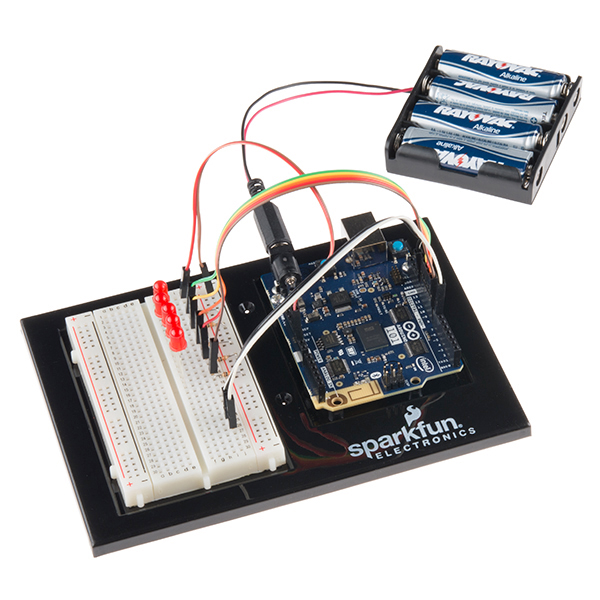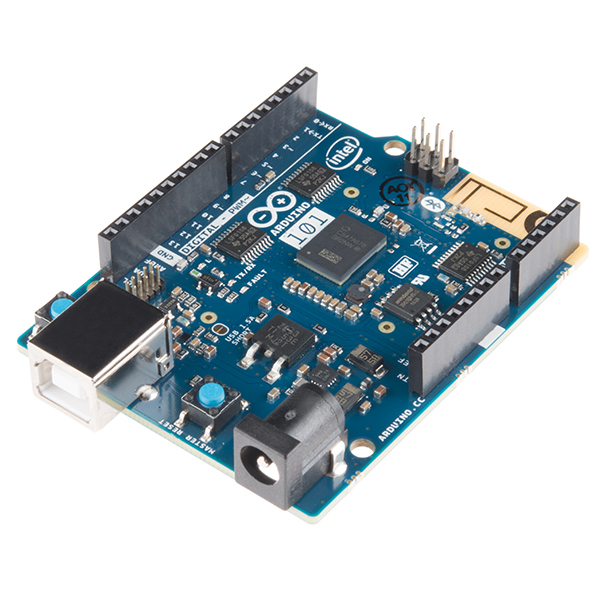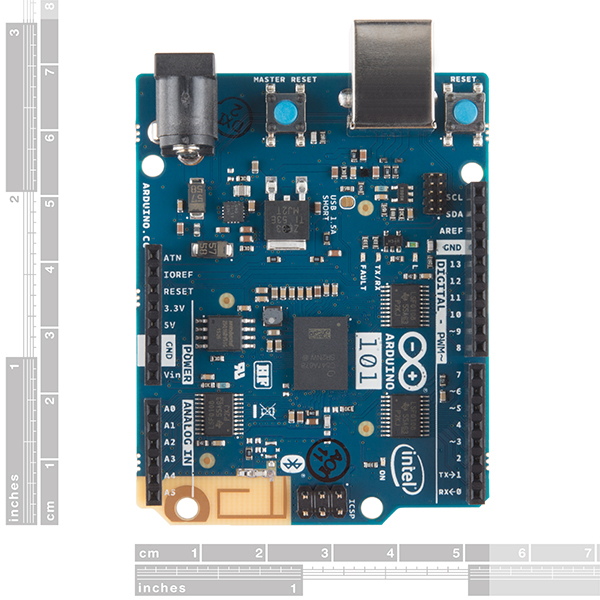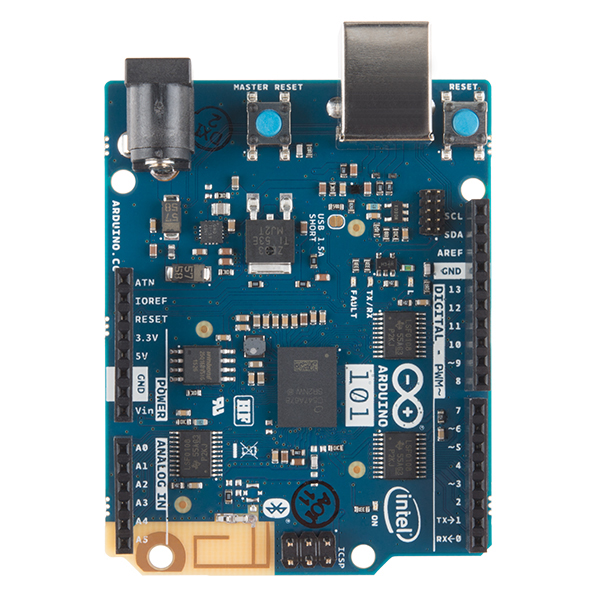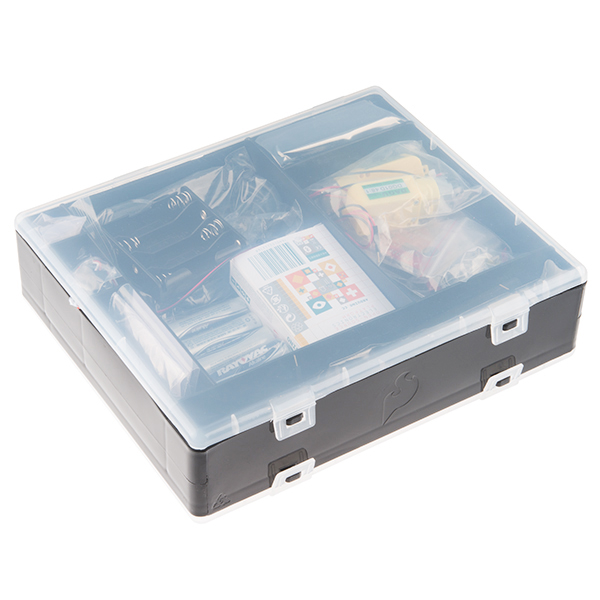SparkFun Inventor's Kit for Arduino 101
The SparkFun Inventor’s Kit for the Arduino 101® board is a great way to get started with programming and hardware interaction with embedded electronics using the Intel® Curie-based Arduino 101 board.
This 101 SIK includes everything you need to complete 21 circuits that will teach you how to control and read the on-board and external sensors, control the Arduino 101 board through your phone, detect and analyze different sounds, and much more. Don't worry; you won't need any previous programming or electronics experience to use this kit. The philosophy behind this kit is that anyone can (and should) play around with cutting-edge electronics. After using this 101 SIK, you’ll have the know-how to start creating your own projects and experiments. From building robots and game controllers to IoT and data logging, the world will be your oyster.
The online Experiment Guide for the Arduino 101 board contains step-by-step instructions on how to connect each circuit with the included parts. Full example code is provided and explained, and troubleshooting tips are included in case something goes wrong.
The kit does not require any soldering and is recommended for anyone comfortable reading code libraries or anyone looking for an alternative to the original SparkFun Inventor’s Kit.
Note: The Arduino 101 Inventor's Kit is now only restricted in Argentina, Brazil, China, Indonesia, Japan, Nepal, South Korea, and Taiwan. If you are in one of the aforementioned countries we apologize. Arduino is currently working on Trademark rulings in those areas. This product may be delayed by two to three business days to verify shipping address. We will contact you after you place your order if we need anything.
Note: The Real-Time Operating System (RTOS) and framework developed by Intel was scheduled to be open sourced in March 2016. It's not possible to interface with it directly; only the Arduino core can do it via static mailboxes.
- Arduino 101 Board
- Arduino and Breadboard Holder
- White Solderless Breadboard
- Carrying Case
- SparkFun Mini Screwdriver
- 16x2 White on Black LCD (with Headers)
- SparkFun Sound Detector (with Headers)
- SparkFun Motor Driver - Dual TB6612FNG (1A) (with Headers)
- Hobby Gearmotor - 200 RPM (Pair)
- Battery Holder - 4xAA to Barrel Jack Connector
- 74HC595 Shift Register
- Transistor - NPN (BC337)
- 1N4148 Diodes
- Small Servo
- TMP36 Temp Sensor
- USB Cable A to B - 6 Foot
- Jumper Wires - Connected 6in. (M/M, 20 pack)
- Photocell
- Tri-color LED
- Red, Blue, Yellow, and Green LEDs
- Red, Blue, Yellow, and Green Tactile Buttons
- 10K Trimpot
- Piezo Speaker
- SPDT Mini Power Switch
- 100 Ohm and 10K Resistors
- 1500 mAh Alkaline Batteries - AA
- Experiment 1: Blinking an LED
- Experiment 2: Reading a Potentiometer
- Experiment 3: Driving an RGB LED
- Experiment 4: Driving Multiple LEDs
- Experiment 5: Reading a Button Press
- Experiment 6: Reading an SPDT Switch
- Experiment 7: Reading a Photoresistor
- Experiment 8: Color Mixing with the RGB
- Experiment 9: Reading a Temperature Sensor
- Experiment 10: Driving a Servo Motor
- Experiment 11: Using a Transistor
- Experiment 12: Using the Motor Driver
- Experiment 13: Motor Driver with Inputs
- Experiment 14: Using a Piezo Buzzer
- Experiment 15: Using the Sound Detector Board
- Experiment 16: Using a Shift Register
- Experiment 17: Using an LCD
- Experiment 18: Reading the Onboard Accelerometer
- Experiment 19: Tap Detection
- Experiment 20: Using the Onboard Real-Time Clock (RTC)
- Experiment 21: Using the Onboard Bluetooth Low Energy (BLC)
SparkFun Inventor's Kit for Arduino 101 Product Help and Resources
SIK Experiment Guide for the Arduino 101/Genuino 101 Board
April 28, 2016
This guide contains all the information you will need to explore the 21 circuits of the SparkFun Inventor's Kit for the Arduino 101/Genuino 101 Board.
Core Skill: Robotics
This skill concerns mechanical and robotics knowledge. You may need to know how mechanical parts interact, how motors work, or how to use motor drivers and controllers.
Skill Level: Noob - You will be required to put together a robotics kit. Necessary parts are included and steps will be easy to follow. You also might encounter basic robotics components like bearings, mounts, or other hardware and need a general idea of how it goes together.
See all skill levels
Core Skill: DIY
Whether it's for assembling a kit, hacking an enclosure, or creating your own parts; the DIY skill is all about knowing how to use tools and the techniques associated with them.
Skill Level: Noob - Basic assembly is required. You may need to provide your own basic tools like a screwdriver, hammer or scissors. Power tools or custom parts are not required. Instructions will be included and easy to follow. Sewing may be required, but only with included patterns.
See all skill levels
Core Skill: Programming
If a board needs code or communicates somehow, you're going to need to know how to program or interface with it. The programming skill is all about communication and code.
Skill Level: Rookie - You will need a better fundamental understand of what code is, and how it works. You will be using beginner-level software and development tools like Arduino. You will be dealing directly with code, but numerous examples and libraries are available. Sensors or shields will communicate with serial or TTL.
See all skill levels
Core Skill: Electrical Prototyping
If it requires power, you need to know how much, what all the pins do, and how to hook it up. You may need to reference datasheets, schematics, and know the ins and outs of electronics.
Skill Level: Rookie - You may be required to know a bit more about the component, such as orientation, or how to hook it up, in addition to power requirements. You will need to understand polarized components.
See all skill levels
Comments
Looking for answers to technical questions?
We welcome your comments and suggestions below. However, if you are looking for solutions to technical questions please see our Technical Assistance page.
Customer Reviews
No reviews yet.

